The Iron-Press
3D scanning and reproduction of historical type
Research into the practices of early printing is constrained by the world-wide scarcity of printer's type surviving from this period; later type differs in significant ways. Three-dimensional capture of the shapes rare examples of early pieces of type--and/or of the books it was used to print--will enable us to manufacture fresh supplies of printer's type containing the long-lost typefaces, and with a working iron printing press we can test these fresh supplies in recreations of the actual printing processes they were designed for. This is timely because mass-scanning of early books has produced thousands of fresh images just as new digital manufacturing techniques enable the recreation of the processes by which these books were made. Understanding how these books were made enables us to judge how accurately they reflect the author's words they aim to reproduce and, for example, to correct printing errors that would otherwise be undetectable.
This is a project funded by the Higher Education Innovation Fund (HEIF) and led by Professor Gabriel Egan that is partnering with the Bodleian Library in Oxford and St Bride's Printing Library in London to attempt to reproduce some of these partners' most interesting and rare pieces of type, matrices (the molds used to cast metal type) and punches (the tools used to make matrices). As a preliminary experiment we have tried various techniques for three-dimensional scanning using existing (non-rare) samples of type possessed by the CTS.
Hand-held and simple table-top laser scanners turn out to be just insufficiently accurate to capture the all-important detail of the letter-face on the top of a piece of type. Also, with some desktop scanners the laser beam cannot reach into the nooks and crannies of the typeface so they cannot be captured.
 << Ideal piece of type Bad scan of actual piece of type >>
<< Ideal piece of type Bad scan of actual piece of type >> 
In the above example, the technique of photogammetry was being tried: this involves taking multiple two-dimensional photographs and having the computer combine them as a three-dimensional model. Clearly, this isn't the way to go. Our sample for this was a particularly small piece of metal type, and we also have larger pieces made of wood (so-called xylographic type) that we wish to reproduce, like this one:
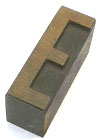 The very best table-top scanner made a reasonable fist of this:
The very best table-top scanner made a reasonable fist of this:
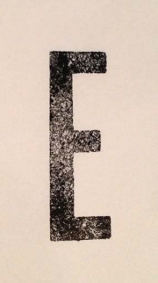 << Inked impression
<< Inked impression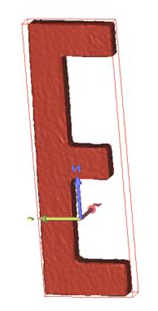 << 3D models >>
<< 3D models >> 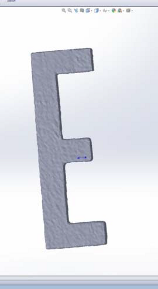
Another way to go is to scan the two-dimensional shape of the top plane of the piece of type to capture its distinctive outline (what is commonly but misleading called in word-processing the font), to use that outline as the template from which to draw the typeface in two-dimensional artwork drawing software, and then to import this image to three-dimensional modelling software and extrude it to make the full three-dimensional model:
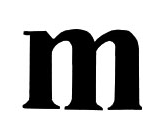 << 2D drawing of typeface 3D extruded image >>
<< 2D drawing of typeface 3D extruded image >> 
Is that cheating? We need to do more experiments to see what are the very best results we can achieve with the finest table-top laser scanners. If we refine the process, can we achieve results as good as those for the large xylographic type when using the much smaller metal type? Once we settle on a method for making our models, then we will be experimenting with computer assisted manufacture of the reproduction type in a variety of materials including metal, wood, resin, and plastic.
